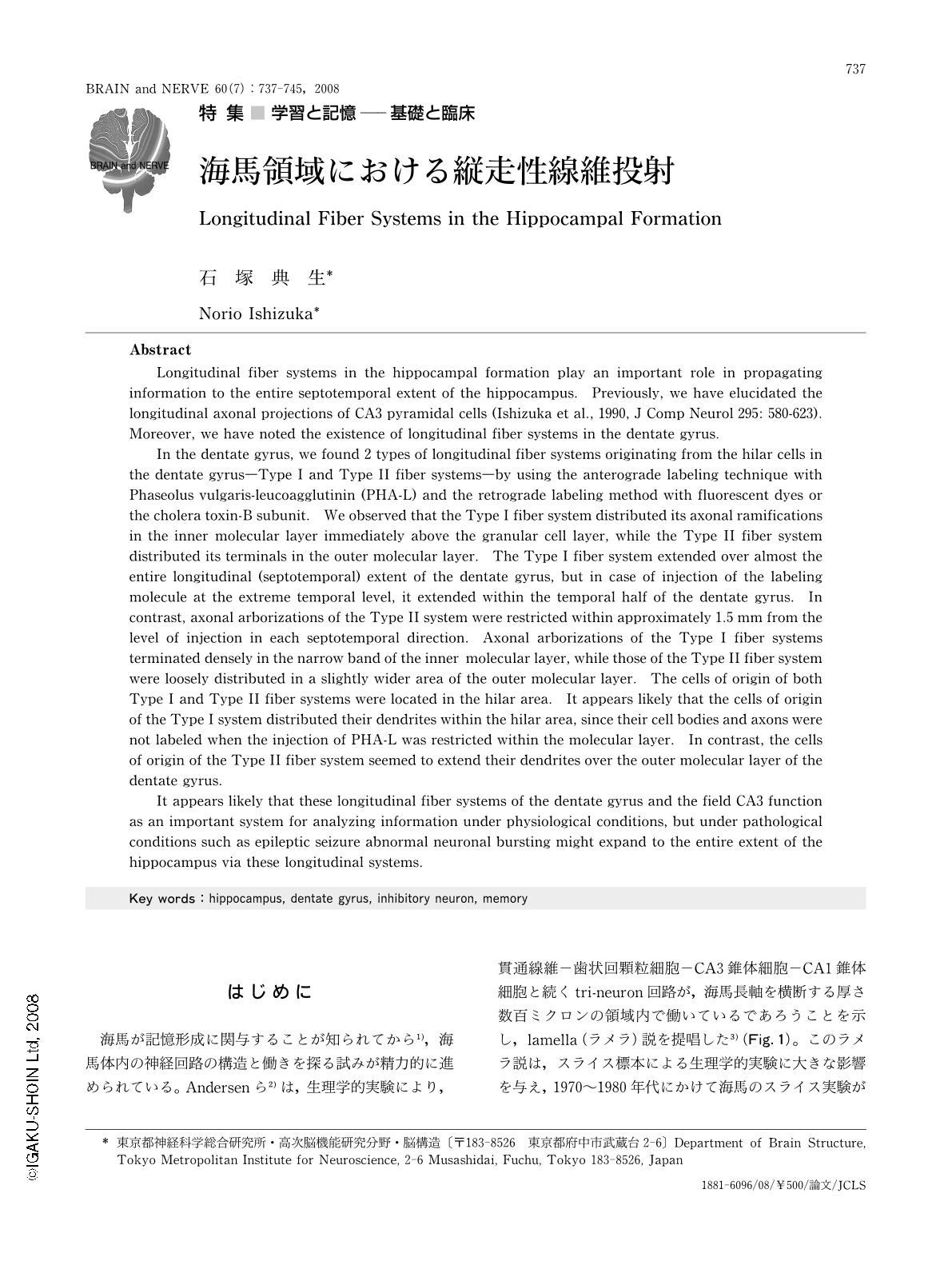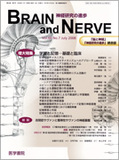Japanese
English
- 有料閲覧
- Abstract 文献概要
- 1ページ目 Look Inside
- 参考文献 Reference
はじめに
海馬が記憶形成に関与することが知られてから1),海馬体内の神経回路の構造と働きを探る試みが精力的に進められている。Andersenら2)は,生理学的実験により,貫通線維-歯状回顆粒細胞-CA3錐体細胞-CA1錐体細胞と続くtri-neuron回路が,海馬長軸を横断する厚さ数百ミクロンの領域内で働いているであろうことを示し,lamella(ラメラ)説を提唱した3)(Fig.1)。このラメラ説は,スライス標本による生理学的実験に大きな影響を与え,1970~1980年代にかけて海馬のスライス実験が盛んに行われた。筆者もこの海馬スライス標本内で連続すると考えられていたtri-neuron回路の全貌を解剖学的に見たいと考え,歯状回顆粒細胞,CA3・CA1錐体細胞,海馬台錐体細胞をHRP(horseradish peroxidase)細胞内染色法により染色し,その軸索投射の形態解析を始めた。しかしながら,CA3錐体細胞から出るSchaffer側枝はCA1領域へ達することはほとんどなく,大多数の細胞の軸索側枝はスライス標本の上面あるいは下面で切断されていた。このことは,CA3錐体細胞の軸索はスライス切片内ではCA1に達しないことを強く示唆した。その後PHA-L(pheseolus vulgaris-leucoagglutinin)順行性標識法をin vivoで用いることで,CA3錐体細胞の軸索が実際には海馬長軸方向にかなりな距離走っていることを明らかにした4)。同時に,歯状回内にも縦走性線維投射があることを報告した。一方,CA1錐体細胞の白板線維5)および歯状回顆粒細胞の苔状線維6)は海馬長軸にほぼ直交するように走っていること,CA1錐体細胞には連合性線維がほとんどみられないこと1,5,7),海馬台錐体細胞は領域内を縦走する線維群が少ないこと8)が知られている。本稿では,海馬体内の各種細胞の軸索投射を解剖学的に再考し,海馬体の形態学的構造9,10)と縦走性線維の意味を考えたい。
Abstract
Longitudinal fiber systems in the hippocampal formation play an important role in propagating information to the entire septotemporal extent of the hippocampus. Previously, we have elucidated the longitudinal axonal projections of CA3 pyramidal cells (Ishizuka et al., 1990, J Comp Neurol 295: 580-623). Moreover, we have noted the existence of longitudinal fiber systems in the dentate gyrus.
In the dentate gyrus, we found 2 types of longitudinal fiber systems originating from the hilar cells in the dentate gyrus―Type I and Type II fiber systems―by using the anterograde labeling technique with Phaseolus vulgaris-leucoagglutinin (PHA-L) and the retrograde labeling method with fluorescent dyes or the cholera toxin-B subunit. We observed that the Type I fiber system distributed its axonal ramifications in the inner molecular layer immediately above the granular cell layer, while the Type II fiber system distributed its terminals in the outer molecular layer. The Type I fiber system extended over almost the entire longitudinal (septotemporal) extent of the dentate gyrus, but in case of injection of the labeling molecule at the extreme temporal level, it extended within the temporal half of the dentate gyrus. In contrast, axonal arborizations of the Type II system were restricted within approximately 1.5 mm from the level of injection in each septotemporal direction. Axonal arborizations of the Type I fiber systems terminated densely in the narrow band of the inner molecular layer, while those of the Type II fiber system were loosely distributed in a slightly wider area of the outer molecular layer. The cells of origin of both Type I and Type II fiber systems were located in the hilar area. It appears likely that the cells of origin of the Type I system distributed their dendrites within the hilar area, since their cell bodies and axons were not labeled when the injection of PHA-L was restricted within the molecular layer. In contrast, the cells of origin of the Type II fiber system seemed to extend their dendrites over the outer molecular layer of the dentate gyrus.
It appears likely that these longitudinal fiber systems of the dentate gyrus and the field CA3 function as an important system for analyzing information under physiological conditions, but under pathological conditions such as epileptic seizure abnormal neuronal bursting might expand to the entire extent of the hippocampus via these longitudinal systems.

Copyright © 2008, Igaku-Shoin Ltd. All rights reserved.


